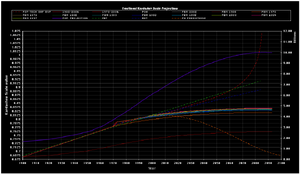
Kardashev scale projections ranging from 1900 to 2100.
The Kardashev scale is a general method of classifying how technologically advanced a civilization is, first proposed in 1964 by the Russian astronomer Nikolai Kardashev. It has three categories, based on the amount of usable energy a civilization has at its disposal and increasing logarithmically:
- Type I — A civilization that is able to harness all of the power available on a single planet, approximately 1016 W. The actual figure is quite variable; Earth specifically has an available power of 1.74×1017 W. Kardashev's original definition was 4×1012 W. (Kardashev had originally defined Type I as a "Technological level close to the level presently attained on earth", "presently" meaning 1964.)
- Type II — A civilization that is able to harness all of the power available from a single star, approximately 1026 W. Again, this figure is variable; the Sun outputs approximately 3.86×1026 W. Kardashev's original definition was 4×1026 W.
- Type III — A civilization that is able to harness all of the power available from a single galaxy, approximately 1036 W. This figure is extremely variable, since galaxies vary widely in size. Kardashev's original definition was 4×1037 W.
All such civilizations are purely hypothetical at this point. However, the Kardashev scale is of use to SETI researchers, science fiction authors, and futurists as a theoretical framework.
There is also a hypothetical "type IV", which includes such fictional species such as the time-traveling Time Lords in the television series, "Doctor Who". The exact definition of a type IV species is uncertain, however often said to be species that can utilise all the power available from ten billion galaxies (1046 W). Further numbers in the Kardashev scale could be extrapolated, but there is not much use for it because larger amounts of energy approach the limits for the universe.
